Today in Nagasaki
The story of Takashi and Midori Nagai is mysteriously connected to the whole history of Christianity in Japan, which has always had its beating heart in Nagasaki. Everything that has happened in Japan over four centuries-from the work of Jesuit missionaries through thousands of martyrs and Hidden Christians-seems to want to converge on the story of their lives.
The city of Nagasaki is still rich in many evidences of this history, which finds in Takashi and Midori the bright fruit blossomed in the unthinkable tragedy of the atomic bomb and which proves that The Blood of Martyrs is the seed of the Christian community.
The Nyokodō

The Nyokodō, which literally means the Shrine as One's Self, is the 4-square-meter hut in which Takashi Paolo Nagai and his two sons spent the last three years of his life, from 1948 to 1951, bedridden by leukemia and in sought-after evangelical poverty. It stands in Urakami, on the site where he had lived with his wife Midori Marina Moriyama from 1934, the year of their marriage, until the day of destruction by the atomic bomb on August 9, 1945.
Nagai was one of the first citizens of Nagasaki to decide to repopulate and revive Urakami, as early as October 1945. He wanted to resume his home there where his wife Midori had been born and died and where, before them, the ancestors of the Moriyama family itself had lived for seven generations, who had been the leaders of the Hidden Christian community, that people of about 3,000 believers who had passed on the Catholic faith in hiding during the two centuries of atrocious persecution by the samurai government.

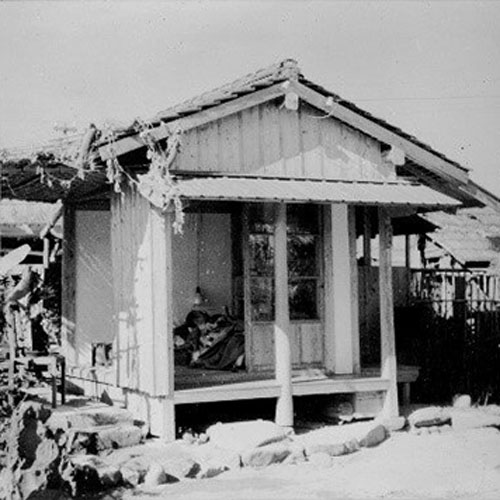
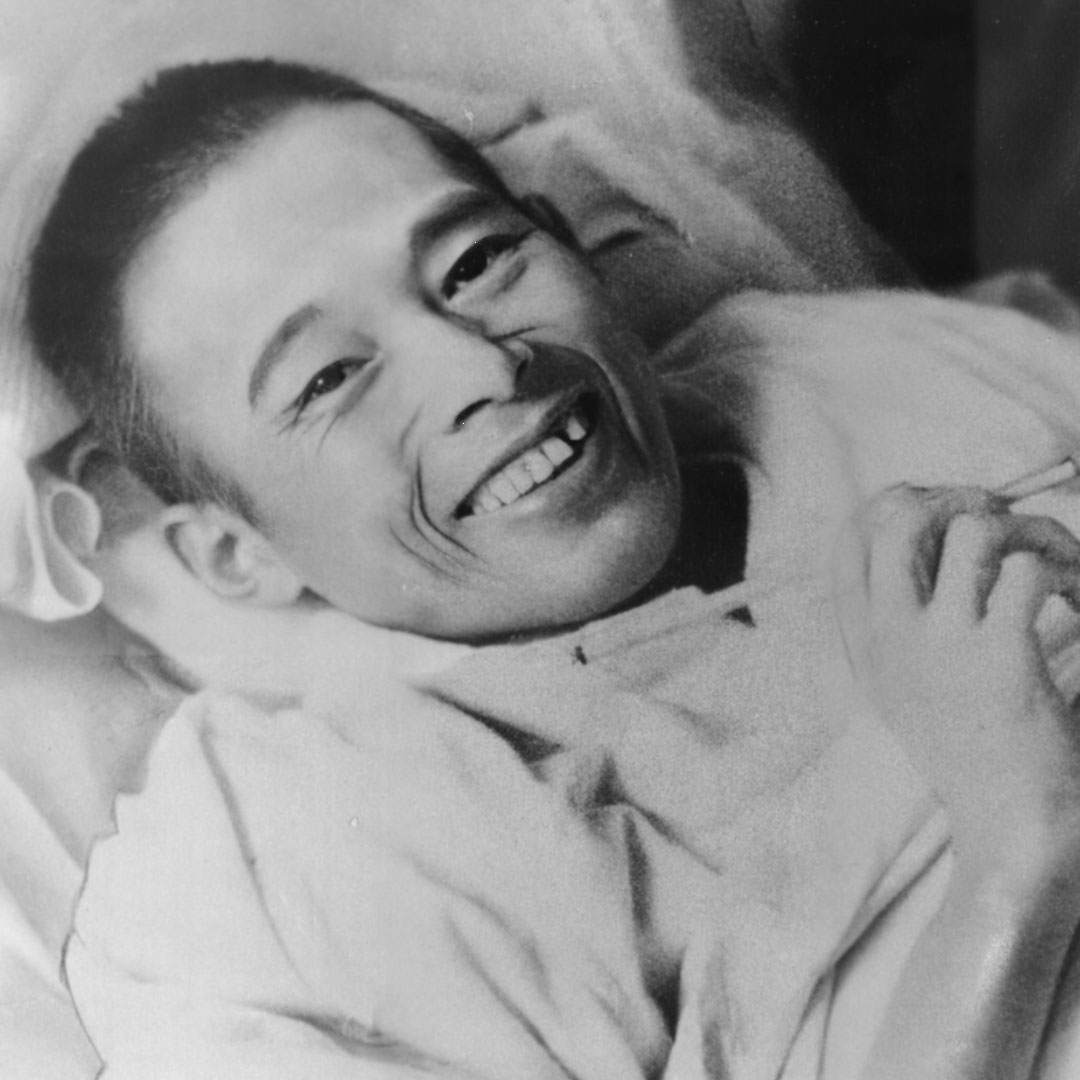
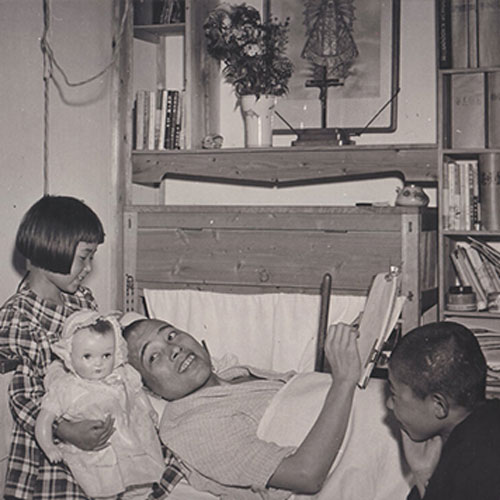
By 1948, when he had the very poor Nyokodō built by his carpenter friends from the St. Vincent fraternity, the already ailing Takashi Nagai had by then earned a good amount of money from the sale of his books. In his book Thoughts from the Nyokodō, he explains his decision to live in total poverty in this way:
"I keep for myself the minimum necessary to live at an essential level like my neighbors and what is left over I donate to increase the culture in my neighborhood. I am certainly not the only one here in the atomic heath living in poverty [...] All my neighbors are equally poor. Every family has to work night and day to barely make a living [...] everyone barely makes ends meet. How could I, alone among everyone, live in luxury?It doesn't matter how much money the sale of my books earns me [...] If we think that the only purpose for which some people are given so much is for them to put it into the service of their fellow man, then it cannot be said that Heaven's plan is unfair [...] Here are some of the things that need to be rebuilt as soon as possible: the church, schools, kindergartens, orphanage, hospital, and the community center for citizens. A lot of money is also needed to clean up the neighborhood from the burned ruins, plant trees, recreate flower gardens and playgrounds for the children. Whatever money we earn will never be enough."
Nyokodō
Address: 22-6 Uenomachi, Nagasaki, 852-8113, Giappone
The Memorial Museum

The Takashi Nagai Memorial Museum stands next to the Nyokodō, where Takashi had a small library built for the children of Urakami, which he renamed Our Box of Books. On the lower floor of the museum is the permanent exhibit of Takashi and Midori Nagai's mementos, including many photographs, Takashi Nagai's autographed drawings, and Midori's rosary beads that Takashi found on the remains of their house, where the kitchen used to be. The beads are all loose and the only metal cross is still intact. From this Nagai understood that Midori had died clutching the cross in her hands and praying the rosary.
A public library is still located on the upper floor, just as Takashi had so desired.




The images above represent: Midori's rosary found by Takashi among the remains of their home; Our Box of Books, the small bookcase built by Takashi; a drawing by Takashi of the destroyed Cathedral, now on display at the Museum; and one of the many photos on view at the Memorial Museum exhibit.
Memorial Museum
Site: https://nagaitakashi.nagasakipeace.jp/japanese/
Address: 22-6 Uenomachi, Nagasaki, 852-8113, Giappone
Sakamoto International Cemetery
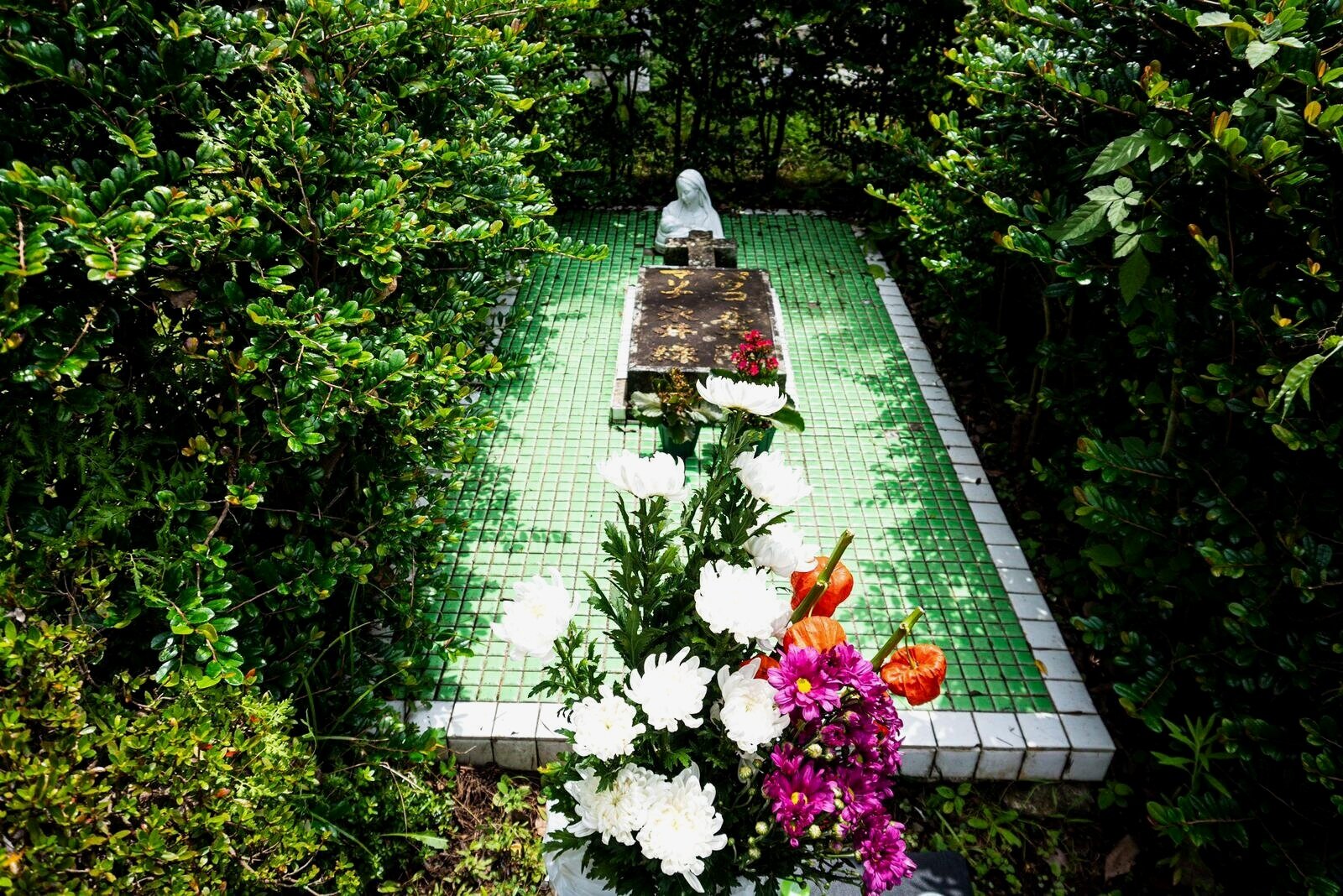
The graves of Midori Marina Moriyama († 9-8-1945) and Takashi Paolo Nagai († 1-5-1951) are in Sakamoto International Cemetery.
Sakamoto International Cemetery
Address: 24-5 Mezamemachi, Nagasaki, 852-8105, Giappone
The Cathedral of St. Mary Immaculate of Urakami

After nearly three centuries of bloody persecution, atrocious torture and executions, in 1873 the government of Japan finally lifted the ban on the profession of the Christian religion. The last survivors of the Hidden Christian people, who had clandestinely preserved and passed on the faith at the risk of their lives, began to build many churches with their own hands and savings, where their communities had lived for centuries. Among the many churches built, the one in Urakami was the most majestic. The church was opened in 1914 and was dedicated to St. Mary Immaculate, but it was not until 1925 that the two bell towers were finished. It was the largest church in the entire East. In 1945 Urakami was the epicenter of the atomic bomb and the church was completely destroyed.
On December 24, 1945 Takashi Nagai and his friends found in the rubble the smaller of the two bells, which was the only one that remained intact. They hoisted it onto a makeshift structure and rang it on the evening of the same year to announce Christmas Eve. It was from this episode that Nagai drew the title of his first book, The Bells of Nagasaki.
The church was one of the first works to whose reconstruction Takashi Nagai and the people of Urakami were immediately dedicated. In the 1960s it would become the cathedral of the Nagasaki diocese.
A head of the so-called Bombed Madonna, which has a moving history behind it, is still preserved in the cathedral. The two-meter-tall wooden statue of Mary Immaculate, made in Italy or perhaps Spain, had been donated to the Christian community in Nagasaki by Spanish Ambassador D. Ulibarri in 1929. It was placed on an altar in the large church and along with the entire building was hit by the explosion on August 9, 1945. In October of that year, Father Kaemon Noguchi, a Japanese soldier and Catholic priest originally from Urakami, set out to pray in the ruins of the church in the hope of finding a tangible relic and found the head of the statue, the only part that, although disfigured, had remained intact. He took it with him to his Trappist monastery in Hakodate, Hokkaido (northern Japan) where he kept it for 30 years. In 1975 Father Kaemon Noguchi returned to Nagasaki to return the Madonnina and handed it over to his cousin, Professor Yakichi Kataoka, a close friend and biographer of Takashi Nagai, who kept it at Junshin Daigaku Tanki University for 15 years, as no more suitable place to store it was yet available. In 1990 Takeshi Kawazoe, pastor of Urakami Church, now Nagasaki Cathedral, expressed a desire to know the story of the find, so Father Noguchi wrote a letter to the church recounting the story. Professor Kataoka, upon learning of it, returned the relic to the church, which kept it at the cathedral's presbytery house. In the year 2005, on the occasion of the 60th anniversary of the atomic bomb, the parish transformed the south transept into a specially created chapel to house the head of the statue of Our Lady Bombed. It was in this chapel that Pope Francis celebrated the Eucharist during his apostolic trip to Japan on November 24, 2019, and it is where it is still venerated today. Our Lady Bomb ed is periodically taken in procession around the world as a symbol of Peace.




The pictures above depict: the Cathedral destroyed by the nuclear blast; the bell of St. Mary's Church, which "survived" the destruction and was pulled out of the rubble by Takashi Nagai's friends; the temporary wooden church adjacent to the ruins, one of the first public utilities rebuilt by the people of Urakami; and Our Lady of the Bomb.
Cathedral of St. Mary Immaculate of Urakami
Site: http://www1.odn.ne.jp/uracathe/
Address: 1-79 Motoomachi, Nagasaki, 852-8112, Giappone
The Convent-Museum of Father Kolbe and Our Lady of Lourdes

Father Maximilian Kolbe (1894-1941) had arrived in Nagasaki with some brethren in April 1930 and founded Mugenzai-no-Sono Monastery on Mount Hiko, about five kilometers east of the city. As early as May of that year they had begun printing the magazine Seibo-no-Kishi(The Knight of the Immaculata). At the convent Father Kolbe wanted to build a replica of the grotto of Our Lady of Lourdes.
In 1935 Takashi Nagai had the opportunity to visit Father Kolbe in his monastery and took an X-ray of his chest as he was suffering from pulmonary tuberculosis. In those same years Nagai was a member of the St. Vincent of Nagasaki fraternity, which met regularly for spiritual exercises at that monastery.
In 1936 Father Kolbe returned to Poland and, as is well known, in 1941 he was interned in Auschwitz concentration camp (serial number 16670) and executed.
In 1945, following the outbreak of the atomic bomb, the friars used Mugenzai-no-Sono Monastery as a shelter for numerous orphans from Nagasaki, to whom they gave hospitality for many years.
Between 1947 and 1951 Takashi Nagai published several articles in the magazine The Knight of the Immaculata.
On September 20, 1945, about a month and a half after the atomic bomb went off, Takashi Nagai began to develop the severe symptoms of atomic disease due to radiation damage to his bone marrow. The wound he had sustained on his left temple resumed bleeding profusely, and he fell into near-coma as he was bleeding to death. His mother-in-law made him drink the blessed water from Father Kolbe's Lourdes spring, and Takashi Nagai says that at that point he heard a woman's voice telling him to pray to Father Kolbe. So he did and the wound suddenly stopped bleeding and began to heal spontaneously.
Today on the site of the Mugenzai-no-sono monastery is a museum of Father Kolbe's relics and testimonies, which has some Takashi Nagai documents on display. One can also visit the grotto of Our Lady of Lourdes, whose water enabled Nagai's miracle.



The images above depict: Father Maximilian Kolbe's cell inside the convent; Father Kolbe selects movable type for the printing of the magazine The Knight of the Immaculate; a medical certificate of Father Kolbe drafted by Takashi Nagai, on display at the convent-museum.
Convent-Museum of Father Kolbe and Our Lady of Lourdes
Address: 1 Chome Hongouchi, Nagasaki, 850-0012, Giappone
The historical sites of the Christians of Japan
The city of Nagasaki was the cradle of Christianity in Japan and the place that preserved the faith during the long centuries of persecution
-
Beginning in 1549, when St. Francis Xavier landed in Kagoshima, and for the next eighty years, Christianity spread very quickly in Japan. Within a few decades it came to have about 600,000 baptized, most of them residents of Nagasaki and surrounding areas. Nagasaki was known in Europe as the "Rome of the East" because it was completely Christian and had many churches.
-
Between 1614 and 1633, persecution of Christians became extremely violent, and many executions were carried out as a warning in Nagasaki on Nishizaka Hill, which was its central and highest point. All churches were destroyed and missionaries driven out or killed. At least 5,000 executions are reported in the few available documents although the number of Christian martyrs is believed to be much higher.
-
For 250 years, between the early decades of the 1600s and 1873, Christianity was completely banned from Japan, and the faithful in the Nagasaki area continued clandestinely to profess the faith, with no more churches, no more priests and no more sacraments, except for baptism, which they imparted themselves. They were the people of the so-called Hidden Christians.
-
In 1863 Christian priests returned to Nagasaki and founded the Oura church. In 1865, 3500 Hidden Christians from Urakami revealed their presence to Father Bernard Petitjean, the French priest of the Oura church. Discovered by the government they were confined to concentration camps and tortured. Many of them died.
-
It was not until 1873 that the bans against Christianity were removed and the prisoners were able to return to Urakami and begin repopulating their villages again. The leaders of Urakami's Hidden Christian community had for seven generations been the firstborn sons of the Moriyama family, from which Marina Midori was descended. It was in the house from which the Moriyamas led these communities that Midori was born, lived as a bride to Takashi, and died on August 9, 1945. And in the same place that Takashi had the Nyokodō built.
-
In 2018, UNESCO declared 22 sites of Japan's Hidden Christians as World Heritage Sites, including the Oura Church and many villages that arose on the Gotō Islands archipelago (Nagasaki Bay) during the centuries of persecution(Hidden Christian Sites in the Nagasaki Region - UNESCO World Heritage Centre; World Heritage Sites | Travel Japan | JNTO).
Recommended locations
Today it is possible to visit many places connected to this story rich in faith, martyrdom and hope.

The Church of Oura
It is the oldest church in Japan and the place where the Hidden Christians of Urakami revealed themselves to Father Bernard Petitjean after 250 years in hiding.
Site: https://nagasaki-oura-church.jp/
Address: 5-3 Minamiyamatemachi, Nagasaki, 850-0931, Giappone

The Museum of the Twenty-six Martyrs of Nagasaki
The museum houses many relics and historical relics of Japan's more than 5,000 martyrs, 16th- and 17th-century missionaries and Hidden Christians. It stands on Nishizaka Hill, the site of many executions, where there is a monument to martyrs St. Paul Miki and 25 Companions(photo left)
Site: http://www.26martyrs.com/
Address: 7-8 Nishizakamachi, Nagasaki, 850-0051, Giappone
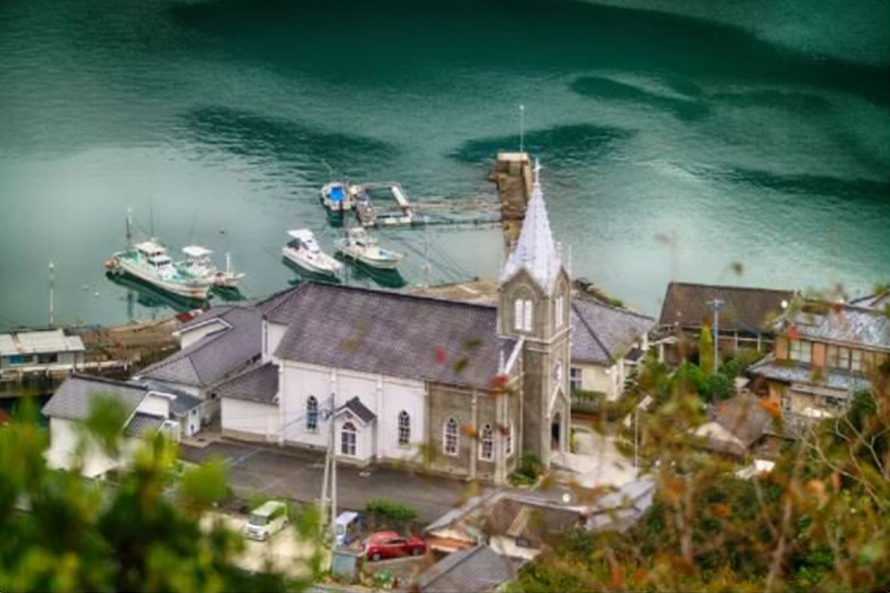
The villages of the Hidden Christians of the Gotō Islands
The five Gotō Islands form an archipelago off Nagasaki Bay. Some 3,000 Hidden Christians migrated there in the 18th century in order to lead their life of faith in hiding with less risk of being discovered. They are home to some ancient villages of Hidden Christians and today are embellished with beautiful churches built in the 19th century, soon after the legalization of the Christian faith.
“The Virgin's Pass”
Make a donation
You can support the Committee's activities and initiatives
by making a donation via credit card or Paypal.
BANK COORDINATES: Banca Intesa San Paolo, Piazza P. Ferrari 10, 20121, Milan. Made out to: Friends of Takashi and Midori Nagai.
IBAN: IT16B0306909606100000178799
BIC/SWIFT (from abroad): BCITITMM
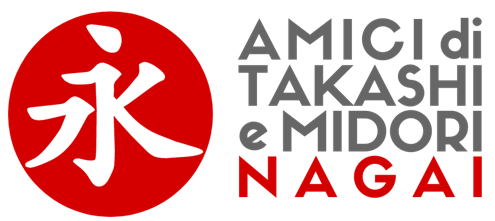
Contact us
"*" indicates required fields


